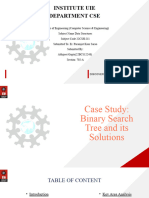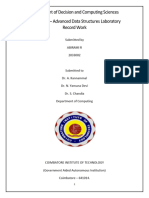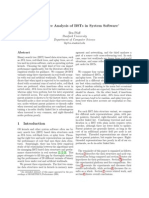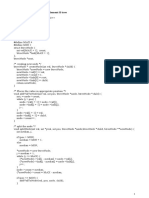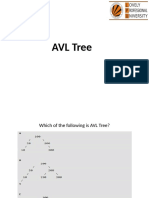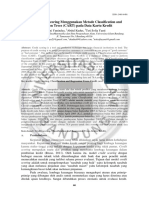Binary Search Tree: A
Comprehensive
Overview
By MasirJafri
2401030600012
�Description of Binary Search Tree Data
Structure
A Binary Search Tree (BST) is a hierarchical data structure that
organizes data in a tree-like format with specific ordering properties.
In a BST, each node contains a value and has at most two children,
referred to as the left child and right child. The fundamental property
that defines a BST is its ordering constraint: for any given node, all
values in the left subtree are less than the node's value, and all values
in the right subtree are greater than the node's value.
Structure and Properties
The BST follows these key structural rules:
• Each node has a maximum of two children
• The left child's value is always less than the parent node's value
• The right child's value is always greater than the parent node's
value
• This property applies recursively to all subtrees
• No duplicate values are typically allowed in a standard BST
Basic Operations
BSTs support several fundamental operations:
• Search: Finding a specific value by traversing the tree
• Insertion: Adding new nodes while maintaining the BST
property
• Deletion: Removing nodes and restructuring the tree as needed
• Traversal: Visiting all nodes in specific orders (in-order, pre-
order, post-order)
�Key advantages
Efficient Search Operations
The most significant advantage of BSTs is their logarithmic search
time complexity. In a balanced BST, search operations take O(log n)
time, making them much faster than linear search algorithms for large
datasets.
Ordered Data Maintenance
BSTs automatically maintain data in sorted order. An in-order
traversal of a BST always produces elements in ascending order,
eliminating the need for separate sorting operations.
Dynamic Size Management
Unlike arrays, BSTs can grow and shrink dynamically during runtime
without requiring predefined size allocation. This flexibility makes
them ideal for applications where the data size varies significantly.
Efficient Range Queries
BSTs excel at range-based operations, such as finding all values
within a specific range or determining the minimum and maximum
values in the tree.
Memory Efficiency
BSTs only allocate memory as needed for new nodes, avoiding the
waste associated with pre-allocated but unused array space.
Real-time-applications
Database Indexing
�Database management systems extensively use BST variants (such as
B-trees and B+ trees) for indexing. These structures enable rapid data
retrieval in large databases by maintaining sorted indexes that can be
searched efficiently.
File Systems
Modern operating systems employ BST-like structures for organizing
file directories and managing file metadata. This allows for quick file
searches and efficient directory traversals.
Expression Parsing
Compilers and interpreters use BSTs to parse and evaluate
mathematical expressions. The tree structure naturally represents
operator precedence and enables efficient expression evaluation.
And many more..
Limitations
Worst-Case Performance Degradation
The most significant limitation of BSTs is their potential
for performance degradation in worst-case scenarios. When data is
inserted in sorted order (either ascending or descending), the BST
becomes essentially a linked list, resulting in O(n) time complexity
for all operations instead of the optimal O(log n).
No Guaranteed Balance
Standard BSTs do not automatically maintain balance, which can lead
to skewed trees that perform poorly. This limitation has led to the
development of self-balancing variants like AVL trees and Red-Black
trees.
Memory Overhead
�Each node in a BST requires additional memory for storing pointers
to child nodes, resulting in higher memory consumption compared to
arrays or other linear data structures.
Cache Performance Issues
BSTs can exhibit poor cache locality because nodes may be scattered
throughout memory, leading to frequent cache misses and reduced
performance compared to array-based structures.
Complex Deletion Operations
Deleting nodes from a BST, particularly nodes with two children,
requires complex restructuring operations that can be computationally
expensive and error-prone to implement.
Limited Concurrent Access
Standard BSTs are not inherently thread-safe, making them
challenging to use in multi-threaded environments without additional
synchronization mechanisms.
Recursive Operations Risk
Many BST operations are implemented recursively, which can lead
to stack overflow issues for very deep trees, particularly in
unbalanced scenarios.


















